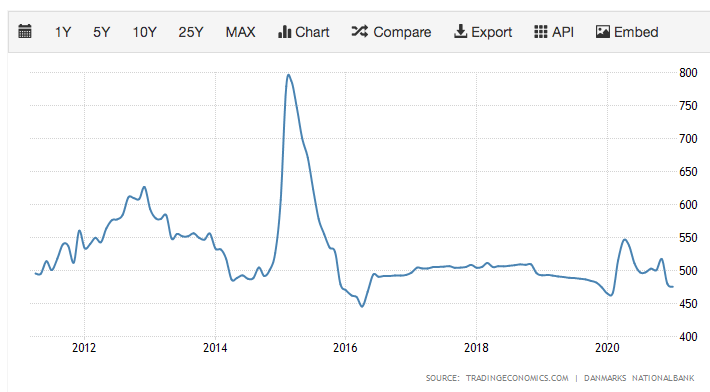Tyler’s test now has an answer
In January 2015, the Swiss made the foolish decision to allow the franc to appreciate strongly, ending a highly successful 3 1/2 year peg with the euro. The Danish krone was also pegged to the euro, and came under intense pressure from speculators. The Financial Times had this to say at the time:
It’s been a long time since so many developed central banks were tested by free market forces. And free market forces aren’t finished yet.
Hot on the heels of the SNB giving up on its euro ceiling policy, the market is zoning in on the Danish central bank and its ability to maintain its euro-peg.
As Dan already pointed out, the Danes have had to cut rates three times in in the last two weeks: January 19, January 22 and January 29.
If that looks and feels desperate, perhaps that’s because it is?
After discussing speculators buying the krone, the FT suggested:
All that, say the analysts, increasingly puts the Danes in the position of the Swiss National Bank: having to gobble up euro-assets they may not want or care for.
The economics world is divided up into two groups. Mainstream economists believe the Swiss National Bank (SNB) was having to buy so many assets because of its weak franc policy, and that allowing the franc to appreciate would reduce this problem, allowing them to buy fewer assets. Many suspected that the Danish central bank would eventually be forced to follow suit.
I argued that this was exactly backwards. A strong franc policy merely whets the appetite of speculators, and the franc is popular partly because speculators correctly anticipate that it will gradually appreciate over the long run. If you don’t like having to “gobble up” so many euro assets, the right policy is to maintain the peg, not allow the franc to appreciate.
At roughly the same time, Tyler Cowen had this to say:
And if the Danes cut their peg, I am loathe to call this [Swiss franc appreciation] a “mistake” (even though it likely will hurt their economy), rather it would be an inevitability.
After more than 6 years, we have a pretty definitive answer to Tyler’s test. It wasn’t inevitable. The Danes did not allow the krone to appreciate. As a result, after a brief surge in early 2015 their central bank balance sheet returned to normal:

Switzerland didn’t do nearly as well. Their monetary base soared right before the revaluation, as markets anticipated that the SNB was about to allow the franc to appreciate, and then continued to grow over time. Countries with the lowest inflation rates (Switzerland, Japan, etc.) tend to have the largest central bank balance sheets.

I’ve talked about this issue before, and long time readers might think I’m beating a dead horse. But I find it maddening that the conventional wisdom still seems to assume that the SNB was forced to revalue the franc under speculative pressure back in 2015. This feeds into the (false) perception that central banks are powerless to inflate, that Lars Svensson’s “foolproof” way of escaping the liquidity trap won’t work. And that’s just wrong. Central banks are never unable to depreciate their currencies.
When people have their minds made up, no amount of empirical evidence seems to budge them.
PS. Ever meet someone who worries about countries engaging in competitive devaluations, and yet also believes that monetary policy doesn’t have any effect on inflation? If monetary policy is powerless, then how can a central bank devalue its currency?

